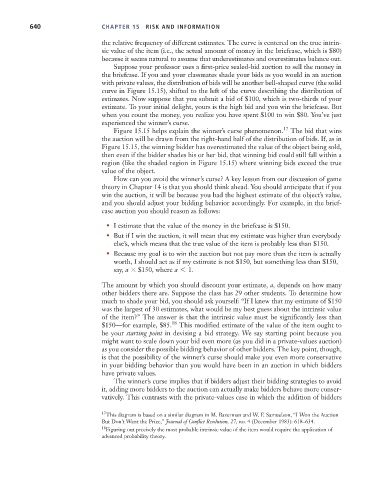Page 666 - Microeconomics, Fourth Edition
P. 666
c15riskandinformation.qxd 8/16/10 11:10 AM Page 640
640 CHAPTER 15 RISK AND INFORMATION
the relative frequency of different estimates. The curve is centered on the true intrin-
sic value of the item (i.e., the actual amount of money in the briefcase, which is $80)
because it seems natural to assume that underestimates and overestimates balance out.
Suppose your professor uses a first-price sealed-bid auction to sell the money in
the briefcase. If you and your classmates shade your bids as you would in an auction
with private values, the distribution of bids will be another bell-shaped curve (the solid
curve in Figure 15.15), shifted to the left of the curve describing the distribution of
estimates. Now suppose that you submit a bid of $100, which is two-thirds of your
estimate. To your initial delight, yours is the high bid and you win the briefcase. But
when you count the money, you realize you have spent $100 to win $80. You’ve just
experienced the winner’s curse.
Figure 15.15 helps explain the winner’s curse phenomenon. 17 The bid that wins
the auction will be drawn from the right-hand half of the distribution of bids. If, as in
Figure 15.15, the winning bidder has overestimated the value of the object being sold,
then even if the bidder shades his or her bid, that winning bid could still fall within a
region (like the shaded region in Figure 15.15) where winning bids exceed the true
value of the object.
How can you avoid the winner’s curse? A key lesson from our discussion of game
theory in Chapter 14 is that you should think ahead. You should anticipate that if you
win the auction, it will be because you had the highest estimate of the object’s value,
and you should adjust your bidding behavior accordingly. For example, in the brief-
case auction you should reason as follows:
• I estimate that the value of the money in the briefcase is $150.
• But if I win the auction, it will mean that my estimate was higher than everybody
else’s, which means that the true value of the item is probably less than $150.
• Because my goal is to win the auction but not pay more than the item is actually
worth, I should act as if my estimate is not $150, but something less than $150,
say, a $150, where a 6 1.
The amount by which you should discount your estimate, a, depends on how many
other bidders there are. Suppose the class has 29 other students. To determine how
much to shade your bid, you should ask yourself: “If I knew that my estimate of $150
was the largest of 30 estimates, what would be my best guess about the intrinsic value
of the item?” The answer is that the intrinsic value must be significantly less than
$150—for example, $85. 18 This modified estimate of the value of the item ought to
be your starting point in devising a bid strategy. We say starting point because you
might want to scale down your bid even more (as you did in a private-values auction)
as you consider the possible bidding behavior of other bidders. The key point, though,
is that the possibility of the winner’s curse should make you even more conservative
in your bidding behavior than you would have been in an auction in which bidders
have private values.
The winner’s curse implies that if bidders adjust their bidding strategies to avoid
it, adding more bidders to the auction can actually make bidders behave more conser-
vatively. This contrasts with the private-values case in which the addition of bidders
17 This diagram is based on a similar diagram in M. Bazerman and W. F. Samuelson, “I Won the Auction
But Don’t Want the Prize,” Journal of Conflict Resolution, 27, no. 4 (December 1983): 618–634.
18 Figuring out precisely the most probable intrinsic value of the item would require the application of
advanced probability theory.

